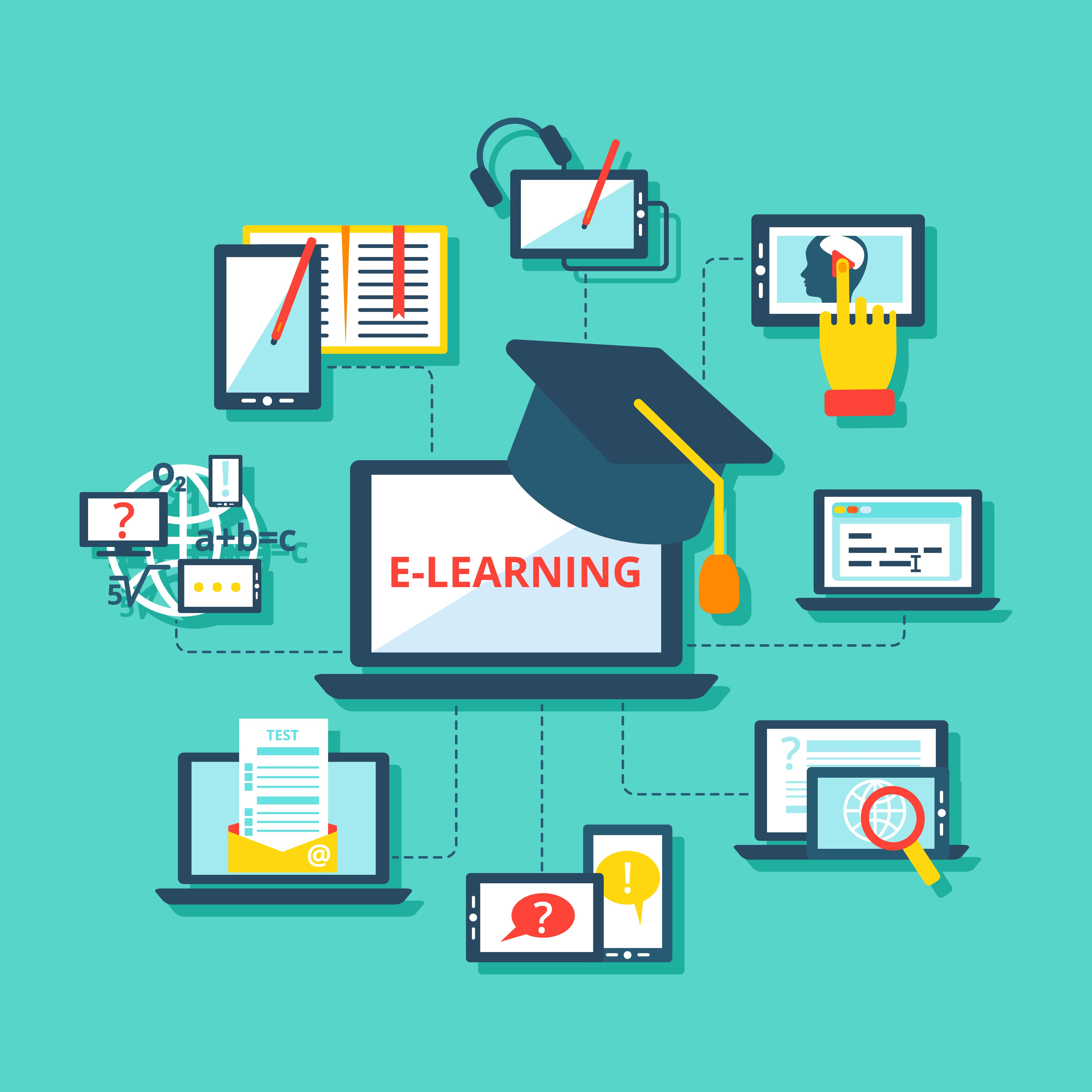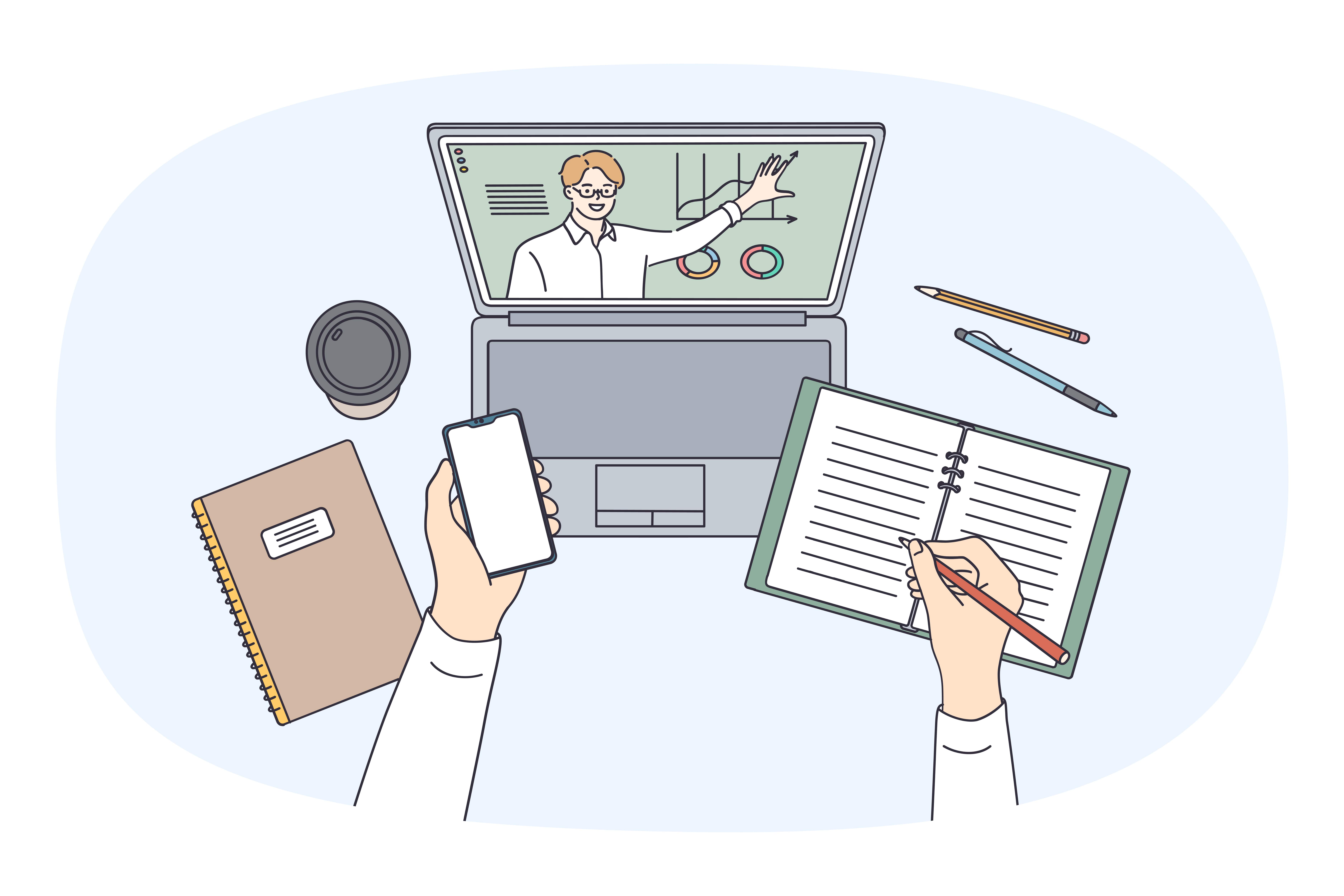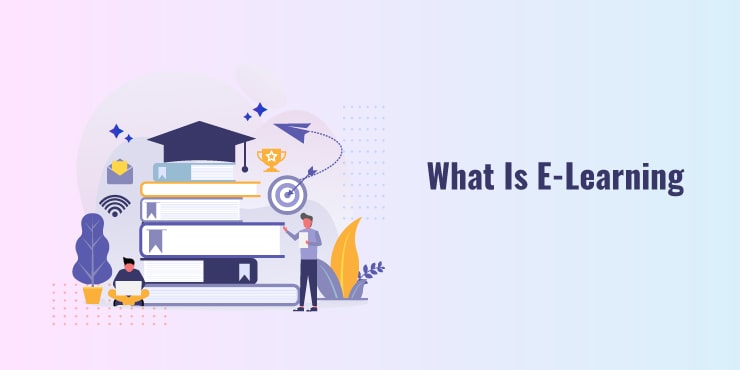So, what is E-learning, and what are the advantages? In today’s world, e-learning has laid such a huge impact on society, both on an educational and commercial basis, that defining it in a few sentences doesn’t seem possible!
It’s such a sweet topic; we all want to dig deeper!
E-learning has made learning outside the classroom not just possible but ultra-convenient also! Just imagine the Covid-19 scene without its existence!
It’s a learning system based on standardized teaching, and we’re using our electronic resources to their best here.
Besides storming education worldwide, e-learning has created millions of openings! As a result, many organizations have flourished, and we can surely say we’re using the technology the best way!
What Is E-Learning: Everything You Should Know
So, what do you mean by E-learning?
This guide embraces in-depth info for the same, and we’ve got some bonus knowledge you come across rarely! Once we go across the definition, we’ll cherish the whole concept of E-learning, how it works, its benefits, the best website for e-learning, and much more!
Definition of the E-Learning
Let’s explain the meaning of e-learning first!
A learning system concentrating on teaching but with the help of digital resources is what we refer to as E-learning. Using computers and the Internet forms are the major parts of E-learning, while teaching can be based in or out of the classrooms.
We can also term E-learning as a network-enabled transfer of skills and knowledge. Education delivery was designed for a large number of recipients at similar or different times. Earlier, we didn’t accept it. We presumed that this system doesn’t have the “human component” that we require in learning.
When Did The Concept Of E-Learning Start?
The term “e-learning” had existed since 1999 when they first used the word at a CBT systems seminar. Other words also searched for an accurate description, such as “online learning” and “virtual learning.”
With the debut of the computer and internet in the 20th century, delivery approaches and e-learning methods and tools expanded. For example, the first MAC from the 1980′s enabled individuals to have computers in their homes, making it easier for them to learn about specific subjects and create certain skill sets.
Then, in the subsequent decade, learning environments started to truly flourish, with individuals gaining access to a wealth of e-learning opportunities and data.

Largest Factors Supporting E-Learning
Which factors have eased? Is e-learning becoming the most famous method to deliver training today?
A few of these factors include:
The Web – Before the growth of the internet, many relied on CD-ROMS printed manuals and other techniques for learning and instruction. The rise of the net allowed organizations to use the flexibility of E-learning and abandon one-dimensional practices.
Development of Multimedia – As E-learning progressed, the ability to incorporate elements such as images, audio, videos, and graphics was a better and more reliable way for students to engage in comparison with traditional learning.
Well-Built Learning Management Systems – LMSs have become more sophisticated, moving from set up to cloud-based systems, with organizations applying them to execute training. There are many things at a minimum to ensure it has the functionality and support you need to satisfy your objectives and those of your students.
Affordable Digital Devices – Contemplating that the very first IBM personal computers price the equivalent of almost $5000 today, it’s understandable that E-learning popularity climbed as electronic devices became cheaper. Mobile learning also enormously facilitated the growth of E-learning.
Let’s Define E-Learning: Advantages
E-learning has proved to be the best way for the corporate sector, especially when MNCs conduct training programs for professionals worldwide. Workers can acquire necessary skills while being present in a board room or from numerous seminars directed at employees of various organizations under one roof.
The schools that have adopted technologies are a step ahead of those with the traditional approach to learning. No doubt, it is just as important to consider the concept of non-electronic teaching with the assistance of books and lectures. Still, efficiency and the importance of technology-based learning cannot be taken lightly or ignored.
It is thought that the mind can easily remember and relate to what’s seen and heard via transferring pictures or videos. Furthermore, it has been found that the brain, holding the student’s interest for longer periods, also retains artwork.
Various sectors, including agriculture, education, business, medicines, services, and government installations, are adapting to the modern concept of E-learning, which supports the nation’s progress.
Now, let us get deeper:
Online Learning Fulfills Everybody’s Needs
This method of studying is best for everyone. This digital revolution has brought remarkable changes in the content we obtain, consume, discuss, and share.
Office goers and housewives can also take educational courses that suit them. Based on comfort and accessibility, many people choose to learn in the evenings or on weekends.
Could Be Taken Lectures At Any Time
Unlike classroom lectures, together with online learning, it’s possible to access the material unlimited times. When planning for an exam, this is particularly required at the time of revision.
If you can’t attend the lecture, you have to get ready for this subject on your own with the help of E-learning; whenever you feel free, attend the lectures online in e-Learning.

Offers Access to Upgraded Content
An advantage of learning online is that it makes sure that you are in synchronization with modern learners. It allows the learner to get fresh content whenever they want it.
Rapid Delivery Of Lessons
E-learning is a way to provide fast delivery, of course. Compared to the traditional classroom instruction method, this mode has quick delivery cycles. It shows that the time necessary to learn decreases to 25%-60% of what is required. There are some reasons why E-learning reduces the learning period:
- A lesson began quickly and was wrapped up in one learning session. It allows training programs to roll out in a few weeks or even days.
- Learners can conveniently define their own learning pace rather than after the rate of the whole group.
- It saves time for a student who doesn’t have to travel to the training venue. It’s possible to learn in your place’s comfort.
- Students may opt to study relevant and specific regions of the learning material. In other words, they can skip the unnecessary areas that they don’t want to learn.

Scalability & Consistency
E-Learning supports your communication skills, elevates your understanding, and generates policies. Besides that, you come across new coaching, concepts, and thoughts. Whether for formal education or entertainment, E-learning is a great fast learning method!
E-Learning enables educators to get greater coverage to communicate the message. In addition, it ensures that all learners get identical training for this learning manner.
Reduced Costs
E-Learning is cost-effective in comparison to traditional forms of learning. This cost reduction is because learning through this mode happens quickly and easily. As a result, much of the training time decreases concerning course materials, travel, trainers, and accommodation.
This cost-effectiveness will also help in boosting the profitability of a company. Also, once you’re studying at your place, you’re free from paying for travel expenses such as lodging, etc., when training happens in another city or state and external learning stuff.
Effectiveness
- E-learning positively affects companies’ profitability because it makes it simple to grasp the content and easily digest it.
- It results in improved scores on tests, certifications, or other kinds of evaluation.
- More students who achieve ‘pass’ or mastery level.
- Ability to learn and execute the processes or knowledge at the workplace.
- Assist in retaining information for a long period.
Less Impact on the Environment
It protects the environment to many extents, as eLearning is a method that doesn’t require any paper. As per a study done on eLearning classes, it’s been discovered that distance-based learning programs consumed approximately 90% less power and generated 85% less amount of CO2 emissions compared to traditional campus-based educational courses.
There is no requirement to cut trees to get papers. Therefore, eLearning is an effective way of learning without impacting the environment.
Which are the Best E-learning websites – get the full-length article HERE!

Corporate E-learning vs. Educational sector E-learning
E-learning enables business executives and students to learn at any time and anywhere. You can learn virtually from any place with a mobile device and internet connection or a computer, which means “study from home,” on holiday, or during your vacation.
However, E-learning is much more than advantages, and there are differences between e-learning in education and the corporate sector. Corporate training’s role is to guarantee a worker has the expertise and the knowledge to undertake a particular operation to enable a company to continue to operate.
What Happens in the Corporate Environment?
Information about E-learning related to the corporate world:
Fast-Paced: Enterprise learning is often “fast-paced” since “time is money” in the corporate world. Training needs to be delivered with results in a time frame as possible.
Career-Related: Enterprise learning aids workers in gaining new skills to advance their careers inside the provider. Corporate Learning Management Systems have modules to facilitate that process.
Benefits Organization: Enterprise learning concentrates on technical issues with immediate gains for the business rather than just an advantage. Corporate education must function properly and develop to evolve and ultimate training.
Training vs. Education: Enterprise is often focused on training, while education is mostly about learning through “igniting curiosity.” Training means being prepared for something, learning a skill or being taught before the standard is reached, and practicing it. It has practical implications for any workplace.
Return on Investment: All enterprises require being ability to calculate the (ROI) of their learning investment. In the educational context, the (ROI) is hard to calculate, and frequently, the effects of learning take even years to show.
What Happens in Educational Institutes?
Now, let’s discuss the Information about E-learning related to the educational world:
What Happens in Educational Institutes?
Now, Let’s Discuss the Information About E-learning Related to the Educational World:
Compared with corporate e-learning, learning in the education sector focuses mostly on knowledge transfer and not on instruction, i.e., in education, we mainly try to learn things with an international range (e.g., a topic such as math). In contrast, corporate e-learning focuses more on business needs (e.g., brand recruit induction).
We use the word “education” to gain general theoretical knowledge. It might/might not involve learning how to do any specific work, skills, or tasks. However, there’s some overlap, and the term ‘education’ can also refer to a process of education or receiving tuition. In other words, basic training in a field like health services is a blend of theoretical, educational, and practical learning skills.

Convergence
Business e-learning professionals can learn from academic initiatives as well as vice versa. For example, the area is starting to gravitate towards integrating corporate methods on how specific topics are taught from the classroom, affirming the classroom of academics.
Especially regarding blending technologies, they’re shifting the model to use the technologies on the corporate side.
There’s a clear overlap: corporate learning, as an example, taking devices like mobile phones to school or work, is becoming increasingly popular with students.
Learners have access to the (WWW) World Wide Web and social networks via these mobile devices, so the technology needed to gather information, create content, and speak with other people is readily available and creates an environment conducive to learning.
Education and corporate businesses are trying to answer the exact questions: for studying how we can use these? How can instructional design and teaching methods and concepts apply to deliver content via mobile devices? So it’s only natural for understanding if we share it throughout the table.
Types of E-Learning
A few educational scientists have identified types of e-learning based on learning tools, while some have chosen to concentrate on metrics like synchronicity & learning content. The following section will filter these findings down into 10 different kinds of e-learning.
Information About E-learning: 10 Distinct Kinds
Alternatively, some educators have chosen to classify types that were e-learning. They identify only two primary sorts of e-learning: internet-based e-learning and computer-based e-learning.
This classification method could be more accurate as it distinguishes learning from online learning. For example, some e-learning like CML and CAL aren’t required to learn online; however, they are considered types of e-learning.
Computer Managed Learning (CML)
If we talk about computer-managed learning (CML), also called Computer Managed Instruction (CMI), computers are utilized to handle and assess learning processes. Computer-managed learning programs operate through information databases.
These databases include pieces of advice that the student must learn, together with lots of ranking parameters that enable the system to be individualized based on the preferences of every student.
As a consequence of communication between the pc and the student, we can determine whether the students attained their learning goals per desire or not. Otherwise, we can repeat the procedures until the students have achieved their learning goals.
Furthermore, educational institutions utilize computer-managed learning systems for storing & retrieving help in education management. It could include information, for example, grades, lecture information, curriculum information, training materials, etc.
Computer-Assisted Instruction (CAI)
CAI, which is for Computer-Assisted Instruction, is sometimes known as computer-assisted learning (CAL). It ”s just another kind of e-learning that uses computers jointly with traditional teaching. It could mean software for the students or the type of training applications that Patrick Suppes of Stanford University utilized in 1966.
Training techniques use a combination of multimedia, including text, audio, images, and videos, to enhance learning.
CAI’s primary value is interactivity — it allows students to become learners instead of students by using various methods like quizzes. And other computer-assisted teaching & testing mechanisms.
Most colleges nowadays, both traditional and online, use variations of computer-assisted learning to facilitate the development of skills and knowledge among their students.

Synchronous Online Learning
Synchronous learning allows groups of students to participate in a learning task from any place in the world at the same time. Real-time synchronous learning often entails videoconferencing and online chats while having the ability to communicate with all the other participants. In addition, these tools allow teachers and training participants to answer and ask questions.
This learning became possible with the rapid evolution of online learning technology. Before the computer networks’ invention in the 1960s, it truly was impossible to implement.
Nowadays, as it eliminates lots of the common pitfalls of e-learning, these pitfalls include social isolation and poor teacher-to-student relationships. Therefore, synchronous e-learning is extremely valuable. As a result, synchronous e-learning is presently among the hottest and quickest growing kinds of e-learning.
Asynchronous Online Learning
Talking about online instruction, groups of students study independently without communication taking place with each other at various times and locations. They give students more flexibility. We often consider Asynchronous methods to be more student-centered than their Synchronous counterparts.
Those students prefer Asynchronous e-learning and don’t have flexible programs for all these reasons. It permits them to learn conveniently at their own pace. For learning, they could set their timeframes, and they aren’t needed to learn along with other students at specific time intervals.
Before the invention of the PLATO computer program, as there were accessible, we considered all e-learning to be Asynchronous.
However, with the availability of the (WWW) World Wide Web and computers, determining between synchronous and Asynchronous e-learning becomes a much more difficult job, as each has its pros & cons.
Fixed E-Learning
Fixed E-learning is a fancy name for something you likely already know about them. In this context, the word “Fixed” means that the material used during the learning process doesn’t change from its initial condition. All the participating students get the same information as all the others.
The teachers predetermine the materials and don’t adapt to students’ tastes. This sort of learning has been mainstream in conventional classrooms for centuries. Still, it is not ideal in e-learning surroundings because fixed e-learning doesn’t use the precious real-time information gained from student inputs.
Making changes to the materials based on the information and analyzing each student separately through their information leads to better learning outcomes for all students.
Adaptive E-Learning
Adaptive is modern and innovative e-learning, making it feasible to adapt and redesign learning materials for each learner.
Can implement laboratory-based adaptive instructional methods? Adaptive e-learning tools enable proper instruction to become more individualized and student-centered.
Where can implement laboratory-based adaptive instructional methods can implement laboratory-based adaptive instructional methods for mathematical sequencing of pupil data? We are now then.
It could signify a new era for educational science when done properly. However, this type of e-learning may be more difficult to plan and accomplish than traditional teaching methods. Therefore, we understate its possible effectiveness and value of it.

Linear E-Learning
When referring to human-computer interaction, communication ensures that Information passes from sender to recipient, without exception.
However, concerning e-learning, this becomes a very limiting factor, as it doesn’t permit communication between students and teachers.
Although it’s getting less relevant with time, this type of e-learning has its place in education. Sending training materials to students is an example of linear e-learning.
Interactive Online Learning
Interactive e-learning allows senders to become recipients and vice versa and allows a communication channel between the parties involved. Students and teachers may adjust their teaching and learning methods in the messages received and sent.
For this reason, it’s much more popular than standard since it allows teachers and students to communicate more freely with each other.
Personal Online Learning
Personal learning in this context highlights the number of students participating in achieving the learning goals. This sort of learning has been mainstream in classrooms for thousands of years.
When practicing personal learning, the students study the learning materials on their own (individually). The expectation from them is to fulfill their learning goals by themselves.
This sort of learning isn’t excellent for growing communication skills and teamwork abilities in students. It focuses on students studying independently without linking with other students. Hence, a more modern approach is essential to supplant the communication of skills and abilities.

Collaborative Online Learning
It’s a kind of learning procedure through which numerous students learn and achieve their learning goals as a group. Students need to work and practice teamwork to attain their common learning objectives.
It ensures the formation of successful groups, where each student has to consider every student’s strengths/weaknesses. In addition, it helps in boosting students’ communication skills and teamwork abilities.
Collaborative e-learning enlarges the concept that knowledge develops the best within a group of people. There, they can socialize and learn from each other.
We use this frequently learning in traditional classrooms and not in online courses. However, it’s still a great type of e-learning that can be highly effective if we do it perfectly.
Future of E-Learning
As computer ownership grows across the globe, E-learning becomes viable and accessible and will stay in the future. In addition, Internet connection rates are increasing, and opportunities for multimedia training methods arise.
With the immense improvement of the growth in telecommuting and mobile networks in the past few years, taking all the wonderful features of e-learning on your journey is a reality with portable devices such as smartphones.
Technologies such as social media are currently transforming education continuously. Generally, learning is more expensive, takes a long time, and the results can vary. However, E-learning has been trying for years to polish the way we learn.
The results now are that numerous tools help create interactive courses, inject informal elements, and, most importantly, standardize learning instead of formal learning processes.
What Is E-Learning: The Conclusion
So, what do you mean by E-learning in 2022? Guys, isn’t it amazing?
Most importantly, with time, we’re continuously getting familiar with the new forms of E-learning, and it’s expanding at a tremendous pace. So you, as a learner, have to ensure what form of this concept will be perfect for you and will bring max comfort.
If you choose the right E-learning platform for yourself, you can indeed attain a cool job before the time you expected and pay enough determination there.
So, let’s learn, and look further to earn! After you get to know the best Elearning platforms HERE, you can check the below button and cherish India’s best job portal.

Leave a Reply